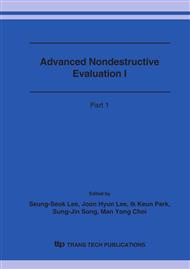p.1465
p.1470
p.1475
p.1479
p.1483
p.1487
p.1491
p.1495
p.1499
Evaluation of Surface and Internal Defects of Railway Wheel using Induced Current Focusing Potential Drop
Abstract:
In the present paper, the induced current focusing potential drop (ICFPD) technique is applied to the detection of surface and internal defects for railway wheels. To detect the defects for railway wheels, the sensors for ICFPD are optimized and the tests are carried out with respect to 4 surface defects and 3 internal defects each other. The results show that the surface defect of 0.5 mm and internal crack of 1.0 mm apart from surface of wheel tread could be detected by using this method. The ICFPD method is useful to detect the defect that initiated in the tread of railway wheels.
Info:
Periodical:
Pages:
1483-1486
Citation:
Online since:
October 2006
Authors:
Price:
Сopyright:
© 2006 Trans Tech Publications Ltd. All Rights Reserved
Share:
Citation:


